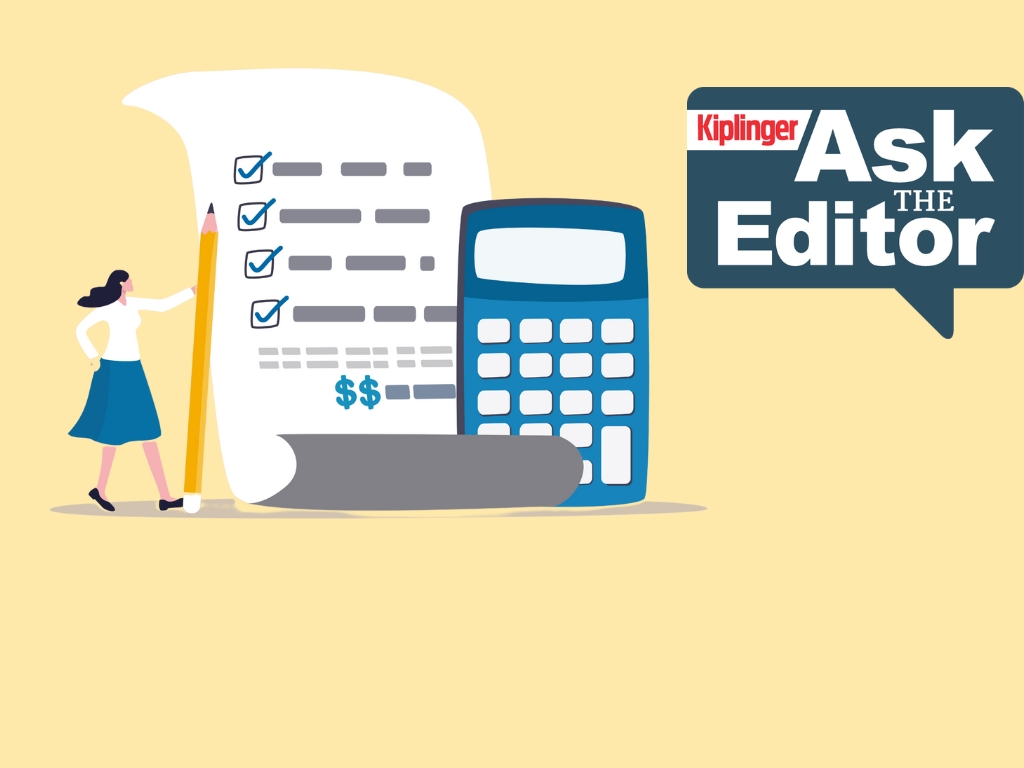Ask the Editor, June 27: Tax Questions on Disaster Losses, IRAs
In our latest Ask the Editor round-up, Joy Taylor, The Kiplinger Tax Letter Editor, answers four questions on paper checks, hurricane losses, IRAs and timeshares.

Each week, in our Ask the Editor series, Joy Taylor, The Kiplinger Tax Letter Editor, answers questions on topics submitted by readers. This week, she’s looking at questions on paper checks, hurricane deductions, IRAs and timeshare losses (Get a free issue of The Kiplinger Tax Letter or subscribe.)
1. The IRS and Paper Checks
Question: I heard that the IRS will no longer accept paper checks from taxpayers after September 30. Is that accurate?
Joy Taylor: Yes and no. President Trump signed an executive order earlier this year mandating that the Treasury Department get rid of paper checks for recipients of benefits, tax refunds and other payments, effective October 1. He is ordering all federal departments and agencies to use electronic funds transfers, including direct deposit, prepaid card accounts and other digital payment options. That means that after September 30, the IRS should no longer be sending out tax refunds in the form of paper checks. There will be limited exceptions.
That executive order also discusses prohibiting people from mailing paper checks to the government, such as when a taxpayer sends in a tax payment via paper check to the IRS. However, it doesn’t appear that the September 30 deadline applies to government receipts, as it does to government disbursements. Instead, the White House executive order doesn’t set a date, but uses the phrase “as soon as practicable” for this purpose.
2. Traditional IRA and Roth IRAs
Question: Can an individual have a traditional IRA and a Roth IRA at the same time, and can they make contributions to both accounts in the same year?
From just $107.88 $24.99 for Kiplinger Personal Finance
Become a smarter, better informed investor. Subscribe from just $107.88 $24.99, plus get up to 4 Special Issues

Sign up for Kiplinger’s Free Newsletters
Profit and prosper with the best of expert advice on investing, taxes, retirement, personal finance and more - straight to your e-mail.
Profit and prosper with the best of expert advice - straight to your e-mail.
Joy Taylor: Yes, an individual may have a traditional IRA and a Roth IRA at the same time, and the owner can make contributions to both in the same year. However, the aggregate amount of contributions to those IRAs (traditional and Roth) in a year is limited. For 2025, the IRA contribution limit is $7,000 ($8,000 if you are 50 or older). For example, if you are 55 and contribute $3,000 to a traditional IRA in 2025, you can only contribute up to $5,000 to a Roth IRA in 2025.
Note that you must also have compensation, such as wages or self-employment earnings. And there is an income ceiling on making contributions to a Roth IRA. For 2025, the ability to make contributions to a Roth IRA phases out at adjusted gross incomes of $236,000 to $246,000 for joint filers and $150,000 to $165,000 for single filers. This income ceiling doesn't apply to contributions to a traditional IRA.
3. Prior-Year Hurricane Losses
Question: I live in Florida, and in 2022, my home suffered serious damage from Hurricane Ian. I’ve heard the government has recently changed the deduction for disaster losses. But I already filed my 2022 tax return in early 2023. How can I take advantage of this change?
Joy Taylor: Personal casualty losses can be deducted to the extent the losses are attributable to federally declared disasters, such as hurricanes, earthquakes, wildfires, blizzards or flooding, that affect a wide area. Individuals can deduct personal losses on their Form 1040 to the extent not reimbursed by insurance. Your loss is equal to the smaller of the damaged property’s adjusted basis or decline in value, less any insurance proceeds you received or expect to receive.
Legislation passed by Congress last year has tax easings similar to those given to victims of federally declared disasters in 2018-2020. The relief generally applies to disasters that took place in 2021-2024. This would include damage to your home from Hurricane Ian. The law lets individuals deduct personal disaster losses even if they don’t itemize on Schedule A. You can write off uninsured personal losses in excess of a $500 threshold without regard to the "10% of adjusted gross income" offset that generally applies to disaster loss deductions. This net loss is treated as an additional standard deduction for nonitemizers.
Since you have already filed your 2022 Form 1040, you can amend it to take the more generous disaster loss deduction by filing Form 1040-X. Note that you generally have three years from the date you filed your original return to file Form 1040-X to amend your return. If you filed your original return before the April 15 due date, then you have three years from the original April 15 due date to file an amended return. For example, if you filed your 2022 return on March 24, 2023, you have until April 15, 2026, to amend it. When amending your return, you would use Form 4684 to calculate the loss. Follow the instructions on Form 4684 for reporting a “qualified disaster loss.”
4. Selling a Timeshare
Question: I own a timeshare, and I am thinking of selling it. Will I have to pay federal income tax on the sale?
Joy Taylor: Most people who sell a timeshare sell it at a loss. Losses from sales of timeshares held for personal use are nondeductible. If you’re one of the lucky few that sells a timeshare at a profit, you will have capital gain equal to the sales price less your tax basis in the timeshare. Different tax rules apply to sales of timeshares held for rental or mixed personal/rental use.
About Ask the Editor, Tax Edition
Subscribers of The Kiplinger Tax Letter and The Kiplinger Letter can ask Joy questions about tax topics. You'll find full details of how to submit questions in The Kiplinger Tax Letter and The Kiplinger Letter. (Subscribe to The Kiplinger Tax Letter or The Kiplinger Letter.)
We have already received many questions from readers on topics related to inherited IRAs, energy upgrades made to a home and more. We’ll answer some of these in a future Ask the Editor round-up. So keep those questions coming!
Not all questions submitted will be published, and some may be condensed and/or combined with other similar questions and answers, as required editorially. The answers provided by our editors and experts, in this Q&A series, are for general informational purposes only. While we take reasonable precautions to ensure we provide accurate answers to your questions, this information does not and is not intended to, constitute independent financial, legal, or tax advice. You should not act, or refrain from acting, based on any information provided in this feature. You should consult with a financial or tax advisor regarding any questions you may have in relation to the matters discussed in this article.
More Reader Questions Answered
- Ask the Editor: Questions on Tax Deductions and IRAs
- Ask the Editor: Questions on Home Sales and Taxes
- Ask the Editor: Questions on Hobby Losses, Medicare
- Ask the Editor: Questions on Trump's Big Beautiful Bill
- Ask the Editor: Questions on capital gains
Profit and prosper with the best of Kiplinger's advice on investing, taxes, retirement, personal finance and much more. Delivered daily. Enter your email in the box and click Sign Me Up.

Joy is an experienced CPA and tax attorney with an L.L.M. in Taxation from New York University School of Law. After many years working for big law and accounting firms, Joy saw the light and now puts her education, legal experience and in-depth knowledge of federal tax law to use writing for Kiplinger. She writes and edits The Kiplinger Tax Letter and contributes federal tax and retirement stories to kiplinger.com and Kiplinger’s Retirement Report. Her articles have been picked up by the Washington Post and other media outlets. Joy has also appeared as a tax expert in newspapers, on television and on radio discussing federal tax developments.
-
 Dow Adds 646 Points, Hits New Highs: Stock Market Today
Dow Adds 646 Points, Hits New Highs: Stock Market TodayIt was "boom" for the Dow but "bust" for the Nasdaq following a December Fed meeting that was less hawkish than expected.
-
 5 Types of Gifts the IRS Won’t Tax: Even If They’re Big
5 Types of Gifts the IRS Won’t Tax: Even If They’re BigGift Tax Several categories of gifts don’t count toward annual gift tax limits. Here's what you need to know.
-
 The 'Scrooge' Strategy: How to Turn Your Old Junk Into a Tax Deduction
The 'Scrooge' Strategy: How to Turn Your Old Junk Into a Tax DeductionTax Deductions We break down the IRS rules for non-cash charitable contributions. Plus, here's a handy checklist before you donate to charity this year.
-
 The 'Scrooge' Strategy: How to Turn Your Old Junk Into a Tax Deduction
The 'Scrooge' Strategy: How to Turn Your Old Junk Into a Tax DeductionTax Deductions We break down the IRS rules for non-cash charitable contributions. Plus, here's a handy checklist before you donate to charity this year.
-
 IRS Says You Made a Tax Return Mistake? A New Law Could Help You Fight Back
IRS Says You Made a Tax Return Mistake? A New Law Could Help You Fight BackTax Law Updated taxpayer protections change what the IRS must explain on error notices and how long you have to respond.
-
 Tax Refund Alert: House GOP Predicts 'Average' $1,000 Payouts in 2026
Tax Refund Alert: House GOP Predicts 'Average' $1,000 Payouts in 2026Tax Refunds Here's how the IRS tax refund outlook for 2026 is changing and what steps you can take now to prepare.
-
 Ask the Editor, December 5: Capital Gains and Tax Planning
Ask the Editor, December 5: Capital Gains and Tax PlanningAsk the Editor In this week's Ask the Editor Q&A, Joy Taylor answers questions on capital gains tax rates and end-of-year tax planning
-
 New 2026 Tax Change Could Mean More for Your IRA and 401(k) Savings
New 2026 Tax Change Could Mean More for Your IRA and 401(k) SavingsRetirement Savings Here's how the new IRS inflation adjustments will increase the contribution limits for your 401(k) and IRA in the new year.
-
 Pickleball Injuries are Getting Out of Hand for Some Adults
Pickleball Injuries are Getting Out of Hand for Some AdultsAs more older adults take up pickleball, injuries are on the rise. Here's how you can lower your risk and still have a ball.
-
 Are You Prepared to Live Longer? MIT AgeLab Answers Questions
Are You Prepared to Live Longer? MIT AgeLab Answers QuestionsA new measure of longevity readiness indicates that for many Americans, the answer is no — and suggests what is needed to get on track.
-
 Ask the Editor, November 28: Roth Conversions and Tax Planning
Ask the Editor, November 28: Roth Conversions and Tax PlanningAsk the Editor In this week's Ask the Editor Q&A, Joy Taylor answers questions on how to convert a traditional IRA to a Roth IRA.